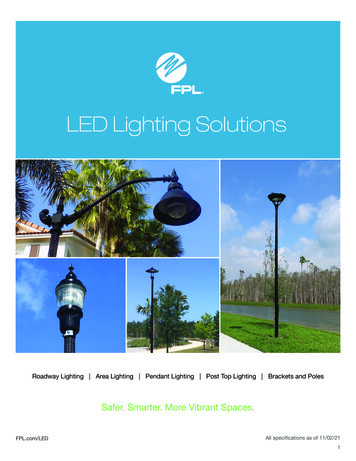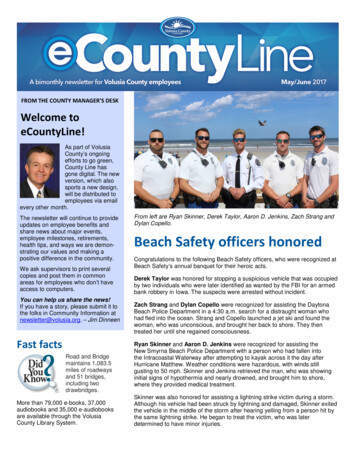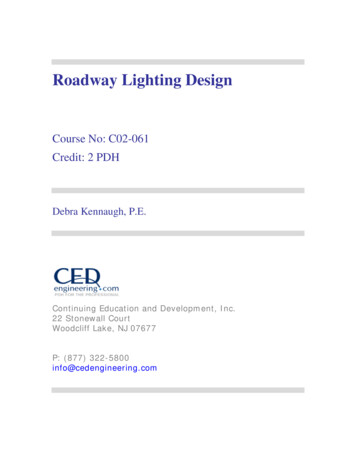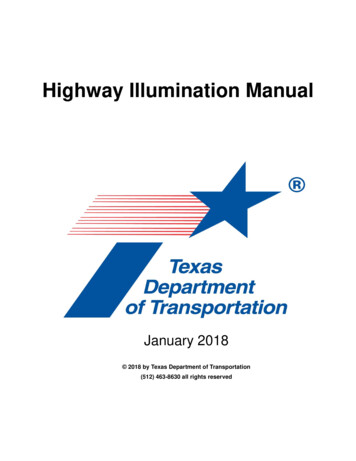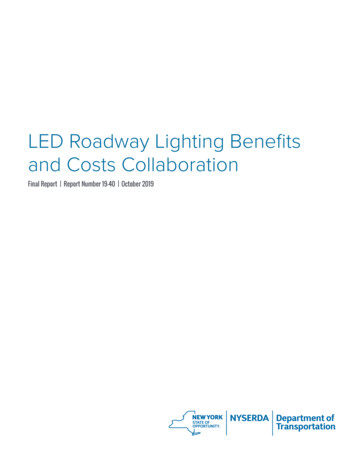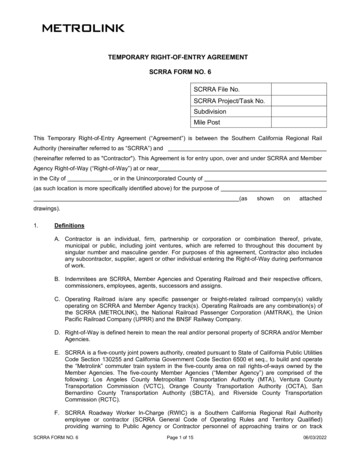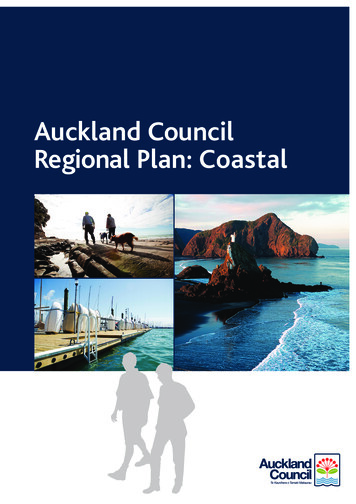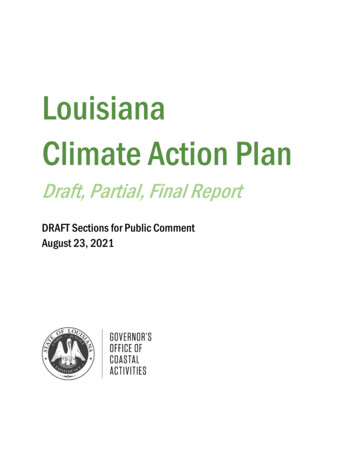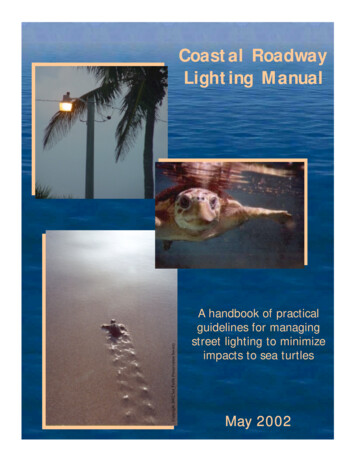
Transcription
Copyright 2002 Sea Turtle Preservation SocietyCoastal RoadwayLighting ManualA handbook of practicalguidelines for managingstreet lighting to minimizeimpacts to sea turtlesMay 2002
COASTAL ROADWAY LIGHTING MANUALA HANDBOOK OF PRACTICAL GUIDELINESFOR MANAGING STREET LIGHTINGTO MINIMIZE IMPACTS TO SEA TURTLESMay 2002Revised by Florida Power & Light Company in consultation with EcologicalAssociates, Inc., Florida Fish and Wildlife Conservation Commission, US Fish andWildlife Service, Florida Department of Transportation, and the FloridaDepartment of Environmental Protection.Originally Prepared in April 1998 byEcological Associates, Inc.PO Box 405Jensen Beach, Florida 34958(772) 334-3729Under Contract toFlorida Power & Light CompanyPO Box 14000Juno Beach, Florida 33408(561) 691-7059
COASTAL ROADWAY LIGHTING MANUALLIST OF TABLES AND FIGURES .iiiUSER’S GUIDE. ivACKNOWLEDGEMENTS.viii1 - INTRODUCTION. 1Purpose . 1Approach . 1Objectives . 32 - SUMMARY OF EFFECTS OF COASTAL LIGHTING ON SEA TURTLES. 5Effects on Adults. 5Effects on Hatchlings. 5How Hatchling Sea Turtles Perceive Light. 63 - SUMMARY OF ISSUES RELATED TO COASTAL ROADWAY LIGHTING11Sea Turtles. 11Importance of Florida’s Nesting Beaches . 11Regulations Protecting Sea Turtles . 12Basic Approach to Roadway Light Management . 13The Nesting Season. 14Roadway Lighting . 16Regulatory Authority. 16Florida Roadway Lighting Standards . 16Altering Roadway Lighting Systems . 17Public Safety . 20Regulation of Utilities. 21Options Offered by Electric Utilities . 22Options Offered by Private Suppliers . 23Low-Pressure Sodium Vapor (LPS) Lighting . 23Experimental Technologies. 24Filters. 24FDOT’s Embedded Roadway Lighting Study. 26Economics. 264 - GUIDELINES FOR IDENTIFYING PROBLEM LIGHTS . 27Disorientation Reports . 27Nighttime Lighting Evaluations . 27Hatchling Arena Assays . 295 - STANDARD APPROACH FOR MINIMIZING LIGHTING IMPACTS . 30Basic Approach to Light Management. 30Keep Light Off The Beach. 31Reduce Total Luminance . 31i
COASTAL ROADWAY LIGHTING MANUALMinimize Potentially Disruptive Wavelengths. 33Employ Best Available Technology . 33Evaluate the Selected Alternative . 34Planning and Design of New Street Lighting Systems . 34Reasons for Managing Lights Rather Than Manipulating Eggs and Hatchlings 356 - ALTERNATIVES FOR MANAGING EXISTING ROADWAY LIGHTING. 37Selectively Eliminate the Light Source . 40Shield the Light Source. 41Change or Modify the Fixture. 42Compress the Lighting Footprint. 42Alter the Light Distribution . 42Use Non-Reflective Interior Surfaces . 43Realign the Fixture . 43Reduce the Mounting Height . 43Relocate the Light Source . 46Reduce Total Illumination . 46Change Spectral Qualities of Light Source. 47Filtering Lenses . 47Low-pressure Sodium Vapor (LPS) Light Fixtures . 47Plant Vegetative Buffers . 47Implement Other Technologies . 487 - ELECTING THE APPROPRIATE ALTERNATIVE. 49Is the Light Visible From the Beach? . 50Distance of Light From the Beach . 50Lights More than 300 Feet From Beach. 50Lights 100 to 300 Feet From Beach . 51Lights Within 100 Feet of Beach. 51Type of Fixture . 52Mounting Height and Wattage. 52Extent of Beach Illumination. 53Summary of Lighting Options. 53LITERATURE CITED. 63APPENDIX A - TECHNICAL WORKING GROUP. 66APPENDIX B - 1998 STEERING COMMITTEE. 69APPENDIX C - STATEMENT FROM USFWS . 72APPENDIX D - COST ESTIMATES FOR LIGHT MANAGEMENT OPTIONS . 74APPENDIX E - GRANTS AND OTHER FUNDING SOURCES .76ii
COASTAL ROADWAY LIGHTING MANUALLIST OF TABLES AND on Coastal County to Sea Turtle Nesting in FloridaBasic Objectives of Effective Streetlight ManagementGuidelines for Achieving Effective Street Lighting SolutionsList of Options That Can be Used Independently or inCombination to Reduce Street Lighting Impacts to Sea TurtlesRelative Effectiveness of Lighting Alternatives (UsedIndependently) in Accommodating Various Street LightingInterestsLight Distribution Patterns (Lighting Footprints) for StreetlightsThe Alternative Selection entation responses of four species of sea turtle hatchlings tocolored light sourcesA hypothetical cone of acceptance that describes how a sea turtlehatchling measures brightest directionWind velocity zones for Florida, as determined by the NESC forelectric utilitiesiiiPage8918
COASTAL ROADWAY LIGHTING MANUALUSER’S GUIDEThis section briefly describes the intent of the Coastal Roadway Lighting Manual,provides an overview of its content, and directs users to those sections of the manual thatmay be of greatest immediate use and/or interest. PLEASE TAKE A FEWMOMENTS TO READ THROUGH THE QUESTIONS BELOW BEFOREPROCEEDING TO THE BODY OF THE DOCUMENT!1. What is the Intent of the Coastal Roadway Lighting Manual?Florida’s beaches serve as important nesting habitat for several species ofthreatened and endangered sea turtles. Artificial light on or near nesting beaches cannegatively affect the nesting process by interfering with normal nocturnal behaviors of seaturtles. Streetlights contribute to this problem.The impetus for the Coastal Roadway Lighting Manual was an accumulatingrecord of impacts to sea turtles from streetlights and an apparent lack of understandingand/or resources needed by lighting custodians to implement effective solutions. Byproviding practical guidelines and identifying resources needed to reduce impacts to seaturtles, this manual is designed to facilitate and standardize light management effortsalong coastal roadways in Florida.2. Am I Required to Take Any Action as a Result of This Manual?The Coastal Roadway Lighting Manual does not impose any new regulations nordoes it establish time frames for bringing streetlights into compliance with applicablelighting regulations. It is merely a tool to assist interested parties in resolving identifiedstreet lighting problems.3. Why Should I Be Concerned About Streetlights That Shine on the Beach?Lights shining on the beach have the potential to interfere with the natural nestingand/or sea-finding ability of sea turtles and may be in violation of local, state and/orfederal laws and regulations. The party responsible for the operation of lights causingproblems for sea turtles could be subject to fines and other penalties. Good faithimplementation of appropriate light management techniques, as presented in the CoastalRoadway Lighting Manual, should substantially reduce exposure to this liability.iv
COASTAL ROADWAY LIGHTING MANUAL4. Must I Compromise Roadway Safety To Protect Sea Turtles?Fortunately, street lighting can generally be managed in a manner that minimizesthe potential for impacts to sea turtles while still providing for adequate nighttimehighway safety. Technological advances presented in the Coastal Roadway LightingManual provide flexibility in accommodating various street lighting interests underdifferent local highway conditions and environmental settings.5. Who is This Manual Intended to Serve?The Coastal Roadway Lighting Manual was developed with the followingaudiences in mind: Utility customer service representatives,Utility field personnel,Traffic planners and engineers,Environmental planners and managers,Regulators,Code enforcement officers,Conservationists, andOthers involved in roadway light management.6. Do I Need a Background In Sea Turtle Biology to Use This Manual?The Coastal Roadway Lighting Manual is intended to serve those with no priorexperience dealing with lighting issues as they relate to sea turtles. The manual containsbasic information on how light affects both adult and hatchling sea turtles, but anunderstanding of that process is not essential to achieving effective light management.Step-by-step guidelines are provided for determining if a light is likely to be a problemfor sea turtles and for resolving previously and newly identified problems.v
COASTAL ROADWAY LIGHTING MANUAL7. I Don’t Have Time to Read the Entire Manual Right Now! Where Should I Start?The Coastal Roadway Lighting Manual includes a step-by-step approach toeffective light management. A variety of background and supporting information is alsoincluded. This supporting information may not be of immediate interest to all users. Theindex below helps guide users to those sections of the manual of greatest immediate needor interest.If you are interested in determining what alternativesare available for resolving street lighting problems,go to . Page 38.If you have a basic understanding of light managementobjectives and would like to select the best alternativefor an identified street lighting problem in your community,go to . Page 49.If you would like to review the basic goals of effectivestreetlight management, go to Page 30.If you would like an overview of the step-by-step approachto effective streetlight management, go to Page 32.If you would like to know how to determine if a particularstreetlight is likely to cause a problem for sea turtles,go to . Page 27.If you are interested in learning more about how lightsimpact sea turtles, go to Page 5.If you are interested in reviewing the various publicsafety, regulatory, and environmental issuesgermane to streetlight management, go to . Page 11.If you would like to review the approach taken duringthe development of this manual or a list of projectparticipants, go to Page 1.vi
COASTAL ROADWAY LIGHTING MANUAL8. Who Can I Contact if I Have Questions Regarding the Content of This Manual?For information regarding the preparation or content of the Coastal RoadwayLighting Manual contact:Robert G. Ernest, Project ManagerEcological Associates, Inc., PO Box 405, Jensen Beach, Florida 34958Voice: (772) 334-3729FAX: (772) 334-4925email: eai@gate.netORFlorette Braun, Principal Environmental SpecialistFPL Environmental Services, PO Box 14000, Juno Beach, Florida 33408Voice: (561) 691-7059 FAX: (561) 691-7070email: Florette Braun@fpl.com9.How Can I Obtain Additional Copies of the Coastal Roadway Lighting Manual?Copies of the Coastal Roadway Lighting Manual, as well as periodicupdates, may be obtained electronically from the Florida Fish andWildlife Conservation Commission through their web site at:http://florida conservation.org/psm/turtles/manual.pdfvii
COASTAL ROADWAY LIGHTING MANUALACKNOWLEDGEMENTSThis document was originally prepared by Ecological Associates, Inc. (EAI) ofJensen Beach, Florida under a contract administered by Florida Power & Light Company.The manual was a collaborative effort involving the electric industry, transportationofficials, regulators, biologists, and local government sponsors with interests in improvedlight management. EAI and FPL would like to thank all project participants for theirsupport and assistance on the original and revised versions of the manual, including:Florida Fish and Wildlife Conservation Commission Florida Department of Environmental Protection U.S. Fish and Wildlife Service Florida Department of Transportation General Electric Lighting Systems, Inc. The City of Delray Beach The City of Fort Lauderdale The City of Hallandale The City of Hollywood The Town of Longboat Key The City of St. Augustine Beach The City of Venice Manatee County Palm Beach County Sarasota County St. Johns County Volusia Countyviii
COASTAL ROADWAY LIGHTING MANUALCHAPTER 1INTRODUCTIONPurposeIn Florida, many important arterial roadways are located near the shore. These roadsprovide beach access to millions of residents and tourists as well as scenic routes betweencoastal towns and cities.Florida's beaches provide important nesting habitat for five species of threatened orendangered sea turtles (Meylan et al., 1995). Activities that directly harm sea turtles,interfere with their essential nocturnal behaviors, or degrade nesting habitat are prohibitedby law under the U.S. Endangered Species Act (ESA) of 1973 and Florida Statutes.The proximity of lighted roadways to sea turtle nesting beaches presents anenvironmental dilemma in Florida. Normal behavior of adult nesting female and hatchlingsea turtles can be altered by artificial light sources near the beach. This can lead to reducednesting by adults and an inability of hatchlings to properly orient to the sea after leaving thenest. Both effects are undesirable. Interference with the sea-finding ability of hatchlings isof particular concern, because it can result in increased mortality of these threatened andendangered species.Under increasing pressure from the U.S. Fish and Wildlife Service (USFWS) andthe Florida Fish and Wildlife Conservation Commission (FWC), local communities aresearching for ways to minimize lighting impacts to sea turtles. For many years, streetlighting problems were dealt with on a case-by-case basis. Different solutions weredeveloped independently for similar problems in geographically distant locations. Somesolutions were effective, while others were not. The intent of this manual is to provide astandard and practical approach to light management on Florida’s coastal roadways. Theguidelines and resources contained herein will facilitate the timely selection andimplementation of lighting modifications that, when properly applied, can reasonably beexpected to reduce the potential for future impacts.ApproachGuidelines and alternative lighting recommendations contained in this manual werethe collaborative effort of a Technical Working Group (TWG). Participants on the TWG(Appendix A) consisted of lighting experts, traffic engineers, public safety personnel, utilitycustomer service managers, biologists, and regulatory agency personnel representing thefollowing:Page 1
COASTAL ROADWAY LIGHTING MANUAL Florida Power & Light Company (FPL),FWC,USFWS,Florida Department of Transportation (FDOT),Delray Beach Police Department,General Electric Lighting Systems, Inc., andEcological Associates, Inc. (EAI).The TWG considered public safety, economic, social, and conservation issues as itevaluated potential lighting solutions. Rather than advocating a single solution for alllighting problems, the focus was on providing a suite of lighting alternatives to provideflexibility in dealing with unique local conditions. Both existing and new technologies werereviewed and evaluated.A Steering Committee was formed to support the TWG (Appendix B). Thiscommittee was comprised of representatives from county and municipal governments withinterests in the development of effective solutions for street lighting problems in theircommunities. Members of the committee assisted in identifying issues of local concern,reviewed and provided recommendations on work products, served as liaisons between theTWG and their respective governing bodies, and contributed to the cost of manualproduction.Because of the complexity of issues involved with street lighting and the diversesocial and environmental settings around the state, satisfactory resolution of roadwaylighting and endangered species conflicts can, at times, be difficult. This manual does notoffer a panacea for all lighting problems. Rather, it provides a practical approach toaddressing problem lights in a manner that is likely to reduce the potential for impacts. Inmost cases, recommended management techniques will completely eliminate a lightingproblem. However, in other situations, additional light management efforts may be neededif the “corrected” problem light continues to interfere with the behavior of sea turtles.Misconceptions abound as to what constitutes a satisfactory “fix” for lightscausing problems for sea turtles. The involvement of recognized experts in the fields ofroadway lighting and sea turtle conservation was intended to lend authority to theguidelines and alternative solutions presented in the manual. All members of the TWGand Steering Committee had an opportunity to review and comment on the originalmanual and the TWG participates in subsequent updates.When properly applied, the light management strategies contained in thisdocument are endorsed by FWC and USFWS, the regulatory agencies responsible forsea turtle conservation and recovery programs in Florida and the U.S., respectively.Page 2
COASTAL ROADWAY LIGHTING MANUALObjectivesThere are many types of lights, other than streetlights, that cause problems for seaturtles on Florida’s beaches. Clearly, all sources of artificial light near the beach must beproperly managed.A recent publication by Witherington and Martin (2000),Understanding, Assessing, and Resolving Light-Pollution Problems on Sea TurtleNesting Beaches, provided an in-depth look at this broader issue and offered practicalsolutions for effective light management. However, streetlights differ from most othertypes of public and private lights, in that they perform a unique public function. Complexissues of highway safety, regulatory constraints, and liability are involved in thesatisfactory resolution of associated lighting problems. Thus, street lighting managementrequires a special understanding and approach that was not previously articulated. That isthe reason for this manual. It is intended to serve as a companion document to theWitherington and Martin (2000) publication.The primary objectives of the TWG during development of the Coastal RoadwayLighting Manual were to:1) Review the various public safety, social, regulatory, economic, andenvironmental issues related to street lighting,2) Review and evaluate existing, as well as new and innovative, technologies forresolving street lighting problems,3) Establish clear and concise guidelines for effective streetlight managementusing best available technology, and4) Within the framework of the controlling issues identified in No. 1 above,prepare a manual that provides a practical and standard approach to addressingcoastal roadway lighting problems in Florida endorsed by USFWS and FWC.This manual is intended to serve a variety of users, including but not limited to: Utilities (field personnel and customer service representatives). Road departments (traffic planners and engineers). Municipalities (code enforcement and environmental managers). Regulatory agencies. Conservation groups.The previous lack of basic guidelines for streetlight management often resulted induplication of effort, inadequate resolution of identified problems, delays in implementationof effective solutions, and/or unnecessary expense. These situations were extremelyfrustrating and frequently led to an adversarial climate between those requiring that lightingbe modified and those responsible for affecting a solution. This project is intended to fosterPage 3
COASTAL ROADWAY LIGHTING MANUALa more cooperative working relationship among lighting customers, lighting custodians,regulators, and conservationists.Page 4
COASTAL ROADWAY LIGHTING MANUALCHAPTER 2SUMMARY OF EFFECTS OF COASTAL LIGHTING ON SEA TURTLESMany animals, including sea turtles, rely on celestial light for visual orientationand/or the timing of periodic behavior. Artificial light that interferes with these essentialbehavioral systems is termed photopollution (Verheijen, 1985). Unlike chemicalpollutants, errant artificial light is not toxic. Nevertheless, it can have profound effects onthe survival of animals that rely on accurate light information to initiate or guide criticalbiological activities (Witherington, 1997).Light cues figure prominently in the reproductive behavior of sea turtles. Errantlighting on or near nesting beaches introduces misinformation to turtles during vitalphases of the reproductive process (Witherington and Martin, 2000; Lohmann et al.,1997).Effects on AdultsSea turtles in Florida nest almost exclusively at night. This adaptive behaviorprotects the female from would-be predators and from over heating.In summarizing our current scientific understanding of how artificial light affectssea turtles, Witherington and Martin (2000) concluded that the most clearly demonstratedeffect of artificial lighting on adults is to deter nesting females from emerging from theocean. In field experiments at undeveloped nesting beaches, both loggerhead and greenturtles showed a significant tendency to avoid stretches of brightly illuminated beach(Witherington, 1992). Additionally, many researchers have noted a relationship betweenthe amount of lighted beach development and sea turtle nest densities. For example,Mattison et al. (1993) noted that emergences of nesting turtles in Broward County,Florida were reduced in areas where lighted piers and roadways were near the beach. Inareas where a glow of artificial light is present behind the dune, loggerhead turtles preferto nest in the darker areas silhouetted by tall buildings and dune vegetation (Salmon et al.,1995).Effects on HatchlingsAlthough there is a tendency for turtles to prefer dark beaches, many do nest onlighted shores. As noted by Witherington and Martin (2000), in doing so, they place thelives of their hatchlings at risk. That is because artificial lighting can impair the ability ofhatchlings to properly orient to the ocean once they leave their nests.Hatchling sea turtles exhibit a robust sea-finding behavior. A direct and timelymigration from the nest to sea may be vital to their survivorship. Although the cuesinvolved in sea finding are complex, hatchlings rely primarily on vision for properPage 5
COASTAL ROADWAY LIGHTING MANUALorientation (Witherington and Martin, 2000; Lohmann et al., 1997). A combination oflight and shapes is thought to be responsible. The extent to which one or the other drivesthe process may be a function of the relative strength of each stimulus.Hatchlings have a tendency to orient toward the brightest direction. There are twomechanisms that would permit this type of orientation, the simplest of which is known asphototropotaxis (a turning and movement toward light). Hatchlings turn first in onedirection and then in the other until the perceived light intensity are balanced betweenboth eyes. When light balance is achieved, they will be facing the brightest direction. Amore complex mechanism, telotaxis (fixation on and movement toward a targetstimulus), allows instantaneous integration of light stimuli from many directions toestablish brightest direction.On natural undeveloped beaches the brightest direction is almost always awayfrom elevated shapes (e.g., dune, vegetation, etc.) and their silhouettes and toward thebroad open horizon of the sea. On developed beaches, the brightest direction is oftenaway from the ocean and toward lighted structures. Hatchlings unable to find the ocean,or delayed in reaching it, are likely to incur high mortality from dehydration andpredators. Hatchlings lured into lighted parking lots or toward streetlights are oftencrushed by passing vehicles (McFarlane, 1963; Philibosian, 1976; Peters and Verhoeven,1994; Witherington and Martin, 2000).When artificial lighting is strongly attractive, hatchlings move in a highly directedbut incorrect path away from the ocean. This behavioral anomaly is termedmisorientation. Less attractive lighting may prevent hatchlings from orienting in aconstant direction either toward or away from the sea. Hatchlings crawling erratically aresaid to be disorientated. Throughout the remainder of this manual, both types ofmisdirected crawling will be referred to as disorientation, as that is the term mostfrequently used by sea turtle conservationists in describing events where hatchlings do notcrawl directly to the ocean after leaving the nest.How Hatchling Sea Turtles Perceive LightTo reduce the effects of artificial lighting on sea turtles, it is first essential tounderstand how sea turtles perceive light in their environment. First, and mostimportantly, strategies to resolve lighting problems must recognize that man’s commonnotions of brightness and color do not apply, because sea turtles and humans perceivelight quite differently.Both the color (wavelength) and relative brightness of light sources are importantin the sea-finding capabilities of hatchling sea turtles (Witherington and Martin, 2000;Lohmann et al., 1997). Green turtles are strongly attracted to light in the near ultravioletto yellow region of the visible spectrum (360 to 600 nm) but are relatively indifferent tolight in the yellow-orange to red region (630 to 700 nm; Figure 1). Loggerhead turtles arealso strongly attracted to short wavelength light, but unlike green turtles,
FPL Environmental Services, PO Box 14000, Juno Beach, Florida 33408 Voice: (561) 691-7059 FAX: (561) 691-7070 email: Florette_Braun@fpl.com 9. How Can I Obtain Additional Copies of the Coastal Roadway Lighting Manual? Copies of the Coastal Roadway Lighting Manual, as well as periodic updates, may be obtained electronically from the Florida Fish and

